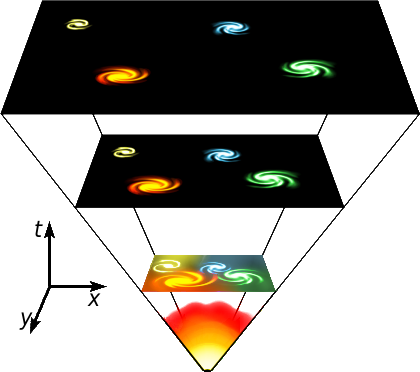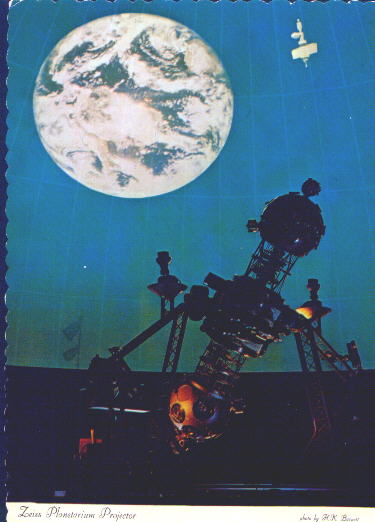 Henry Buhl, Jr., whose 1927 bequest formed the Buhl Foundation,
which funded the 1939 construction of Pittsburgh's original
Buhl Planetarium and Institute of Popular Science.
By Glenn A. Walsh
Reporting for SpaceWatchtower
Henry Buhl, Jr., whose 1927 bequest formed the Buhl Foundation,
which funded the 1939 construction of Pittsburgh's original
Buhl Planetarium and Institute of Popular Science.
By Glenn A. Walsh
Reporting for SpaceWatchtower
An asteroid between the orbits of Mars and Jupiter has been named in memory of wealthy Pittsburgh merchant and philanthropist Henry Buhl, Jr., whose bequest led to the establishment of Pittsburgh's original Buhl Planetarium and Institute of Popular Science in 1939. Asteroid, or more technically correct Minor Planet, (4384) 1990 AA Henrybuhl, which was previously numerically designated but unnamed, was discovered by two Japanese amateur astronomers, Tsutomu Hioki and Shuji Hayakawa, in Okutama Tokyo on 1990 January 3.
This honoring of the memory of Henry Buhl, Jr. comes during the 75th year of Buhl Planetarium. The actual 75th anniversary of The Buhl Planetarium and Institute of Popular Science will be October 24.
The idea for naming a Minor Planet after Henry Buhl, Jr. came, this past Spring, from two staff members of the Henry Buhl, Jr. Planetarium and Observatory at Pittsburgh's Carnegie Science Center, Dan Malerbo (who began as a Planetarium Lecturer at the original Buhl Planetarium) and Frank Mancuso. They proposed the idea to the Minor Planet Center at the Smithsonian Astrophysical Observatory, part of the Harvard - Smithsonian Center for Astrophysics in Cambridge, Massachusetts. The proposal was later approved by the International Astronomical Union, based in Paris.
In 1869, Henry Buhl, Jr., along with his brother-in-law Russell H. Boggs, opened the Boggs and Buhl Department Store in the downtown business district of Allegheny City, Pennsylvania, which today is the Lower North Side of Pittsburgh. Located just across the Allegheny River from Downtown Pittsburgh, Boggs and Buhl soon became one of the leading department stores in the Pittsburgh region. It became a Pittsburgh department store when Allegheny City was annexed by the City of Pittsburgh in 1907.
Henry Buhl, Jr. passed-away on 1927 June 11. He had no heirs, so he had arranged for most of his fortune to be managed by a new foundation to be established in the memory of his wife, Louise, who had died in 1922. At that time with an endowment of $11 million, the Buhl Foundation was one of the ten largest foundations in the country.
In 1935, the Buhl Foundation announced that, as a gift to the City of Pittsburgh, they would completely fund construction of a memorial to Henry Buhl, Jr., that would enhance public education in the city: The Buhl Planetarium and Institute of Popular Science. Opened in 1939 at a cost of $1.07 million, the new educational facility included one of the largest planetarium chambers in the country with a Zeiss II Planetarium Projector, 250-seat Lecture Hall, 800-volume Science Library, and five exhibit galleries. It was the fifth major planetarium built in the United States and the last one constructed before World War II. In 1941, a public astronomical observatory was added, with a rather unique 10-inch Siderostat-type Refractor Telescope.
Although the Buhl Foundation had originally only committed to funding the unfunded deficit of the Buhl Planetarium's operating expenses for the first six years, the Buhl Foundation continued underwriting the operation of Buhl Planetarium until February of 1982. At that time, an independent Buhl Science Center took over operation, but the Buhl Foundation continued assisting with capital and special grants. Buhl Science Center merged with The Carnegie Museums of Pittsburgh (Carnegie Institute) in January of 1987.
The Buhl Foundation provided $1 million when a new Carnegie Science Center was built, on the Ohio River a mile southwest of the original Buhl Planetarium, for construction of a new Henry Buhl, Jr. Planetarium and Observatory in 1991. For the Buhl Foundation's 75th anniversary, the Foundation funded the Henry Buhl, Jr. Chair for the Directorship of The Carnegie Science Center, with an endowment of $3 million. The current Henry Buhl, Jr. Co-Directors of The Carnegie Scienec Center are Ronald J. Baillie (who was hired as Director of Exhibits, Programs, and Technical Services at the original Buhl Planetarium in 1983) and Ann M. Metzger. Additionally, the Buhl Foundation and its Frick Educational Fund (originally the Henry Clay Frick Educational Commission first headed by John Brashear) funds other Carnegie Science Center educational programs including the annual Pittsburgh Regional Science and Engineering Fair (started by Buhl Planetarium in the Spring of 1940) and STEM (Science, Technology, Engineering, Mathematics) programs.
In 2004, the Children's Museum of Pittsburgh, which had originally been housed in the Old Allegheny Post Office across Allegheny Square West Street from the original Buhl Planetarium building, expanded its operation to include the historic Buhl Planetarium building. The $28 million expansion project was aided by a $1.5 million grant from the Buhl Foundation. The Buhl Foundation also provides funding for Children's Museum educational programming.
On 2012 June 23, Buhl Community Park at Allegheny Square opened, replacing the below street-level Allegheny Square Plaza, sponsored by the Buhl Foundation and the Children's Museum of Pittsburgh. The Buhl Community Park at Allegheny Square sits directly between the original Buhl Planetarium and Institute of Popular Science building and the former site of the Boggs and Buhl Department Store.
The Buhl Foundation has also provided funding to assist with capital and programming needs of The Carnegie Library of Pittsburgh and other public libraries in Allegheny County. America's first publicly-funded Carnegie Library, opened in 1890, was located across Federal Street from the original Buhl Planetarium.
Minor Planet (4384) 1990 AA Henrybuhl is a faint object, looking from Earth, with a visual magnitude or brightness of +16. While Earth usually takes 365 days to orbit the Sun, Minor Planet (4384) 1990 AA Henrybuhl takes 1,549 Earth days to make one solar revolution.
Asteroids or Minor Planets have been named after several people and places with local, scientific, or educational reputations:
* Pittsburghia - In honor of the City of Pittsburgh and its scientific and industrial heritage.
* Alleghenia - In honor of the City of Allegheny, Pennsylvania, original home to the Allegheny Observatory.
* Carnegia - In honor of Andrew Carnegie, who funded more than 2,500 public libraries worldwide and financially assisted Pittsburgh's Allegheny Observatory, as well as founding The Carnegie Museum of Natural History and the Carnegie Technical Schools (now Carnegie Mellon University) in Pittsburgh and the Carnegie Institution for Science in Washington (which created Mount Wilson Observatory, among several other scientific departments and laboratories).
* Langley - In honor of Samuel Pierpont Langley, the first professional Director of the Allegheny Observatory, who went on to become Secretary of the Smithsonian Institution.
* Keeler - In honor of James E. Keeler, a Director of Allegheny Observatory who discovered two asteroids and determined the composition of the rings of Saturn with Allegheny Observatory's 13-inch Fitz-Clark Refractor Telescope.
* Brashear - In honor of Astronomer and Telescope-maker John A. Brashear, who served as a Director of the Allegheny Observatory and a Chancellor of the Western University of Pennsylvania (now the University of Pittsburgh).
* Schlesinger - In honor of Astronomer Frank Schlesinger, a Director of the Allegheny Observatory.
* Shapleya - In honor of Astronomer Harlow Shapley, a Director of the Harvard College Observatory, who gave the keynote address at the dedication of the original Buhl Planetarium Observatory in 1941.
* Wagman - In honor of Astronomer Nicholas E. Wagman, a Director of the Allegheny Observatory and one of the first Planetarium Lecturers at Pittsburgh's original Buhl Planetarium and Institute of Popular Science.
* Scanlon - In honor of Leo Scanlon, the co-founder of the Amateur Astronomers' Association of Pittsburgh and one of the first Planetarium Lecturers at Pittsburgh's original Buhl Planetarium and Institute of Popular Science, who developed the first all-aluminum astronomical observatory dome in 1930.
* Kohman - In honor of Carnegie Mellon University Professor of Chemistry Truman Kohman, who had been a very active amateur astronomer.
* Hapke - Asteroid 3549 Hapke was named in honor of Bruce William Hapke, Professor of Planetary Sciences in the Department of Geology and Planetary Science at the University of Pittsburgh, where he has spent his entire career.
* Emmons - Asteroid 5391 Emmons was named in honor of small planetarium pioneer Richard H. Emmons, who used inspiration from Pittsburgh's original Buhl Planetarium to help him and his students construct a small classroom planetarium at the Canton Campus of Kent State University in 1949.
* Misterrogers - In honor of Pittsburgh television icon Fred Rogers, who produced national children's educational television programs for several decades. A children's planetarium show, based on the characters from the
MisterRogers Neighborhood PBS television program, was produced by the Henry Buhl, Jr. Planetarium and Observatory at The Carnegie Science Center in Pittsburgh.
Carnegie Science Center News Release on the naming of Asteroid Henrybuhl:
Link >>>
http://www.carnegiesciencecenter.org/csc_content/press/pdf/2014_June_20_BuhlAsteroid.pdf
Biography of Henry Buhl, Jr.: Link >>>
http://www.buhlfoundation.org/whoweare/henry-buhl-jr.php
History of the Boggs and Buhl Department Store:
Link >>>
http://buhlplanetarium2.tripod.com/bio/boggsbuhl.htm
History of Pittsburgh's original Buhl Planetarium and Institute of Popular Science:
Link >>>
http://buhlplanetarium.tripod.com/75years/quickhistory.html
Related Blog Posts ---
75th Anniversary of America's 5th Major Planetarium (2014 Oct. 24):
Solar Eclipse on Eve of Buhl Planetarium's 75th Anniversary (2014 Oct. 21):
Buhl Community Park at Allegheny Square Opens (2012 June 25):
70th Anniversary: Buhl Planetarium Observatory (2011 Nov. 19):
Source: Glenn A. Walsh, Reporting for SpaceWatchtower, a project of Friends of the Zeiss.
Want to receive
SpaceWatchtower blog posts in your inbox ?
Send request to <
spacewatchtower@planetarium.cc
>..
gaw
Glenn A. Walsh, Project Director,
Friends of the Zeiss <
http://buhlplanetarium.tripod.com/fotz/
>
Electronic Mail - <
gawalsh@planetarium.cc
>
About the SpaceWatchtower Editor / Author: <
http://buhlplanetarium2.tripod.com/weblog/spacewatchtower/gaw/ >
SpaceWatchtower Blog: <
http://spacewatchtower.blogspot.com/
>
Also see: South Hills Backyard Astronomers Blog: <
http://shbastronomers.blogspot.com/ >
Barnestormin: Writing, Essays, Pgh. News, & More: <
http://www.barnestormin.blogspot.com/ >
SPACE & SCIENCE NEWS, ASTRONOMICAL CALENDAR:
<
http://buhlplanetarium.tripod.com/#news
>
Twitter: <
https://twitter.com/spacewatchtower
>
Facebook: <
http://www.facebook.com/pages/SpaceWatchtower/238017839577841?sk=wall
>
Author of History Web Sites on the Internet --
* Buhl Planetarium,
Pittsburgh:
<
http://www.planetarium.cc >
*
Adler Planetarium, Chicago:
<
http://adlerplanetarium.tripod.com
>
* Astronomer, Educator, Optician John A. Brashear:
<
http://johnbrashear.tripod.com >
*
Andrew Carnegie & Carnegie Libraries:
<
http://www.andrewcarnegie.cc >
* Civil War Museum of Andrew Carnegie Free Library:
<
http://garespypost.tripod.com >
*
Duquesne Incline
cable-car railway, Pittsburgh:
<
http://inclinedplane.tripod.com
>
* Public Transit:
<
http://andrewcarnegie2.tripod.com/transit
>









